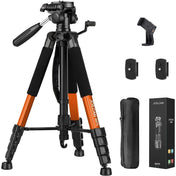There's something truly captivating about wildlife photography. The ability to freeze a moment in time and capture the beauty of animals in their natural habitat is truly a gift. But let's be honest, it's not always easy to snap that perfect shot. Wildlife is unpredictable, and getting close enough for a great photo without disturbing the creatures can be a real challenge. Fear not, fellow nature enthusiasts! We've gathered some expert tips to help you master the art of wildlife photography and bring your Shopify store's nature collection to life.
1. Research and Scout Your Location
Before you venture out into the wild, it's crucial to do your research. Learn about the wildlife species that inhabit the area you plan to visit. Understand their behavior, feeding patterns, and habitat preferences. This knowledge will give you a better chance of finding and capturing the animals in their natural environment. Additionally, scout the location in advance to identify potential spots where you can set up and wait for the perfect shot.
2. Invest in the Right Equipment
While you can take great wildlife photos with a basic camera, investing in the right equipment can significantly enhance your chances of capturing stunning shots. A telephoto lens is essential for getting close-up shots without disturbing the animals. Look for a lens with a long focal length, such as 300mm or higher, to bring distant wildlife up close. A sturdy tripod will also help you stabilize your camera and avoid blurry images, especially when shooting in low light conditions.
3. Patience is Key
Wildlife photography requires immense patience. Animals don't follow a script, and you can't direct them to pose for the perfect shot. Be prepared to wait for long hours, observing their behavior and waiting for the right moment to capture their essence. Remember, the best shots often come to those who wait.
4. Understand Lighting Conditions
Lighting plays a crucial role in any form of photography, and wildlife photography is no exception. Pay attention to the direction and quality of light during different times of the day. The golden hours, which are the first hour after sunrise and the last hour before sunset, provide a soft and warm light that can add a magical touch to your photos. Avoid harsh midday sunlight that can create harsh shadows and wash out colors. Experiment with different lighting conditions to add depth and drama to your wildlife images.
5. Master the Art of Camouflage
Getting up close to wildlife without disturbing them requires mastering the art of camouflage. Wear neutral-colored clothing that blends with the surroundings to avoid startling the animals. Avoid bright colors, which can attract their attention and make them wary of your presence. Additionally, learn to move slowly and quietly, minimizing any sudden movements that might scare off your subjects. Remember, you're stepping into their world, so be respectful and unobtrusive.
6. Capture the Animals in Action
While still portraits can be beautiful, capturing animals in action can bring your wildlife photos to life. Try to anticipate their movements and behavior. Is there a bird about to take flight? Is a deer grazing peacefully in a meadow? These moments of action and interaction create compelling and dynamic images. Patience and timing are key to capturing these fleeting moments, so be ready with your camera and always be on the lookout for interesting behavior.
7. Learn to Use Your Camera's Settings
Understanding your camera's settings is essential for wildlife photography. Familiarize yourself with aperture, shutter speed, and ISO settings to have full control over your images. A wide aperture (low f-stop number) will create a shallow depth of field, isolating your subject from the background. A fast shutter speed will freeze action, allowing you to capture animals in motion. Experiment with different settings to achieve the desired effect and mood in your wildlife photographs.
8. Respect Wildlife and Their Habitat
As wildlife photographers, it's crucial to prioritize the well-being of the animals and their habitat. Respect their space and do not disturb or stress them for the sake of a photograph. Keep a safe distance and use a telephoto lens to capture close-ups without interfering with their natural behavior. Avoid trampling vegetation or leaving any trace of your presence. Remember, we are guests in their world, and it's our responsibility to protect and preserve it.
9. Tell a Story with Your Photos
Great wildlife photography not only captures a beautiful image but also tells a story. Look for unique moments, interactions, or behaviors that can evoke emotions and intrigue viewers. Consider the composition, the background, and the overall narrative when framing your shots. Create a connection between the viewer and the subject, allowing them to experience the wonder and beauty of the natural world through your lens.
10. Share Your Passion and Knowledge
Lastly, don't keep your wildlife photography skills to yourself! Share your passion and knowledge with others. Start a blog, create tutorials, or host workshops to inspire and educate fellow nature enthusiasts. By sharing your experiences and techniques, you contribute to the growing community of wildlife photographers and help raise awareness about the importance of conservation.
In Conclusion, Embrace the Wild
Wildlife photography is an exhilarating and rewarding pursuit. It requires patience, skill, and a deep appreciation for the natural world. With the right equipment, knowledge, and a touch of luck, you can capture incredible moments in the lives of animals. So, venture into the wild, armed with your camera and a sense of wonder. Embrace the challenges, relish the moments, and let your photographs tell the untold stories of the magnificent creatures we share this planet with.











